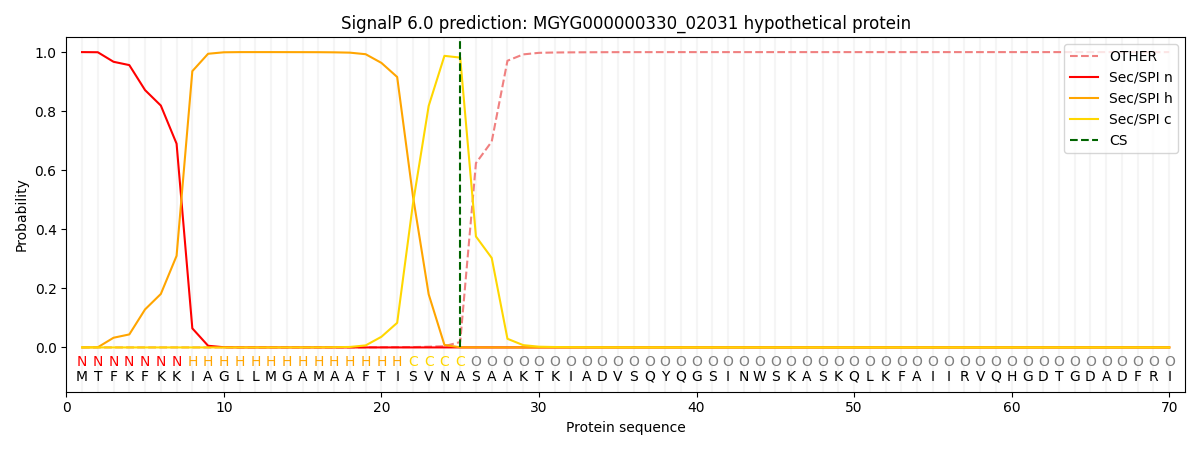You are browsing environment: HUMAN GUT
CAZyme Information: MGYG000000330_02031
You are here: Home > Sequence: MGYG000000330_02031
Basic Information |
Genomic context |
Full Sequence |
Enzyme annotations |
CAZy signature domains |
CDD domains |
CAZyme hits |
PDB hits |
Swiss-Prot hits |
SignalP and Lipop annotations |
TMHMM annotations
Basic Information help
| Species | Lentilactobacillus parabuchneri | |||||||||||
|---|---|---|---|---|---|---|---|---|---|---|---|---|
| Lineage | Bacteria; Firmicutes; Bacilli; Lactobacillales; Lactobacillaceae; Lentilactobacillus; Lentilactobacillus parabuchneri | |||||||||||
| CAZyme ID | MGYG000000330_02031 | |||||||||||
| CAZy Family | GH25 | |||||||||||
| CAZyme Description | hypothetical protein | |||||||||||
| CAZyme Property |
|
|||||||||||
| Genome Property |
|
|||||||||||
| Gene Location | Start: 41965; End: 42870 Strand: - | |||||||||||
CAZyme Signature Domains help
| Family | Start | End | Evalue | family coverage |
|---|---|---|---|---|
| GH25 | 34 | 201 | 1.7e-32 | 0.9887005649717514 |
CDD Domains download full data without filtering help
| Cdd ID | Domain | E-Value | qStart | qEnd | sStart | sEnd | Domain Description |
|---|---|---|---|---|---|---|---|
| cd06523 | GH25_PlyB-like | 2.73e-62 | 31 | 210 | 1 | 177 | PlyB is a bacteriophage endolysin that displays potent lytic activity toward Bacillus anthracis. PlyB has an N-terminal glycosyl hydrolase family 25 (GH25) catalytic domain and a C-terminal bacterial SH3-like domain, SH3b. Both domains are required for effective catalytic activity. Endolysins are produced by bacteriophages at the end of their life cycle and participate in lysing the bacterial cell in order to release the newly formed progeny. Endolysins (also referred to as endo-N-acetylmuramidases or peptidoglycan hydrolases) degrade bacterial cell walls by catalyzing the hydrolysis of 1,4-beta-linkages between N-acetylmuramic acid and N-acetyl-D-glucosamine residues. |
| cd00599 | GH25_muramidase | 1.78e-28 | 31 | 210 | 1 | 186 | Endo-N-acetylmuramidases (muramidases) are lysozymes (also referred to as peptidoglycan hydrolases) that degrade bacterial cell walls by catalyzing the hydrolysis of 1,4-beta-linkages between N-acetylmuramic acid and N-acetyl-D-glucosamine residues. This family of muramidases contains a glycosyl hydrolase family 25 (GH25) catalytic domain and is found in bacteria, fungi, slime molds, round worms, protozoans and bacteriophages. The bacteriophage members are referred to as endolysins which are involved in lysing the host cell at the end of the replication cycle to allow release of mature phage particles. Endolysins are typically modular enzymes consisting of a catalytically active domain that hydrolyzes the peptidoglycan cell wall and a cell wall-binding domain that anchors the protein to the cell wall. Endolysins generally have narrow substrate specificities with either intra-species or intra-genus bacteriolytic activity. |
| cd06414 | GH25_LytC-like | 1.84e-26 | 31 | 208 | 2 | 188 | The LytC lysozyme of Streptococcus pneumoniae is a bacterial cell wall hydrolase that cleaves the beta1-4-glycosydic bond located between the N-acetylmuramoyl-N-glucosaminyl residues of the cell wall polysaccharide chains. LytC is composed of a C-terminal glycosyl hydrolase family 25 (GH25) domain and an N-terminal choline-binding module (CBM) consisting of eleven homologous repeats that specifically recognizes the choline residues of pneumococcal lipoteichoic and teichoic acids. This domain arrangement is the reverse of the major pneumococcal autolysin, LytA, and the CPL-1-like lytic enzymes of the pneumococcal bacteriophages, in which the CBM (consisting of six repeats) is at the C-terminus. This model represents the C-terminal catalytic domain of the LytC-like enzymes. |
| COG3757 | Acm | 1.17e-18 | 31 | 221 | 64 | 264 | Lyzozyme M1 (1,4-beta-N-acetylmuramidase), GH25 family [Cell wall/membrane/envelope biogenesis]. |
| pfam19087 | DUF5776 | 1.19e-18 | 232 | 299 | 1 | 67 | Domain of unknown function (DUF5776). Presumed stalk domain found in bacterial surface proteins forming tandem repeats with high sequence identity. This domain is also associated with other known bacterial surface protein stalks and adhesive domains. |
CAZyme Hits help
| Hit ID | E-Value | Query Start | Query End | Hit Start | Hit End |
|---|---|---|---|---|---|
| QOJ84029.1 | 8.20e-214 | 1 | 301 | 1 | 301 |
| QOP50037.1 | 8.20e-214 | 1 | 301 | 1 | 301 |
| APR07473.1 | 8.20e-214 | 1 | 301 | 1 | 301 |
| AFS01195.1 | 2.59e-201 | 1 | 301 | 1 | 301 |
| QUX04736.1 | 1.05e-200 | 1 | 301 | 1 | 301 |
PDB Hits download full data without filtering help
| Hit ID | E-Value | Query Start | Query End | Hit Start | Hit End | Description |
|---|---|---|---|---|---|---|
| 3HMC_A | 4.45e-22 | 32 | 219 | 7 | 187 | Endolysinfrom Bacillus anthracis [Bacillus anthracis] |
| 2NW0_A | 2.18e-20 | 32 | 210 | 3 | 174 | ChainA, PlyB [Bacteriophage sp.],2NW0_B Chain B, PlyB [Bacteriophage sp.] |
| 4JZ5_A | 1.06e-16 | 32 | 208 | 25 | 210 | High-resolutionstructure of catalytic domain of endolysin ply40 from bacteriophage P40 of Listeria monocytogenes [Listeria phage P40] |
| 4FF5_A | 5.14e-11 | 32 | 210 | 54 | 249 | Structurebasis of a novel virulence factor GHIP a glycosyl hydrolase 25 of Streptococcus pneumoniae participating in host cell invasion [Streptococcus pneumoniae] |
| 5A6S_A | 2.49e-08 | 31 | 212 | 23 | 203 | Crystalstructure of the CTP1L endolysin reveals how its activity is regulated by a secondary translation product [Clostridium phage phiCTP1] |
Swiss-Prot Hits download full data without filtering help
| Hit ID | E-Value | Query Start | Query End | Hit Start | Hit End | Description |
|---|---|---|---|---|---|---|
| P26836 | 8.36e-10 | 34 | 288 | 13 | 262 | Probable autolytic lysozyme OS=Clostridium perfringens (strain 13 / Type A) OX=195102 GN=lyc PE=3 SV=2 |
| P25310 | 1.44e-06 | 34 | 209 | 86 | 278 | Lysozyme M1 OS=Streptomyces globisporus OX=1908 GN=acm PE=1 SV=1 |
SignalP and Lipop Annotations help
This protein is predicted as SP

| Other | SP_Sec_SPI | LIPO_Sec_SPII | TAT_Tat_SPI | TATLIP_Sec_SPII | PILIN_Sec_SPIII |
|---|---|---|---|---|---|
| 0.000436 | 0.998790 | 0.000203 | 0.000204 | 0.000185 | 0.000162 |
